San Diego is contemplating the establishment of a multimillion-dollar fund aimed at attracting prestigious sporting events, with the hope of amplifying its global image and boosting tourism. City officials believe the current moment is opportune, especially with significant global events on the horizon and new venues like Snapdragon Stadium now available, alongside the potential upcoming sports arena replacement.
Notably, the proposed fund seeks to lure not only international spectacles like the 2026 men’s World Cup and the 2028 Summer Olympics, but also large youth competitions and unique events that could draw substantial audiences. This initiative could bolster San Diego’s competitiveness in the crowded realm of sports tourism.
“Sports tourism is on the rise across the world,” said Councilmember Raul Campillo, highlighting its economic benefits for local businesses and the city itself. Meanwhile, Sports San Diego, a nonprofit promoting the city for global sports, asserts that San Diego is leaving money on the table in sports tourism revenues. A recent study revealed significant growth in sports event-related travel and spending, underlining San Diego’s need to capture its share of this expanding market.
Mark Neville, the CEO of Sports San Diego, is advocating for an initial allocation of $2.2 million to kickstart this fund. With half of the fund earmarked for attracting new events and the other half for sustaining existing ones, this financial support aims to counterbalance the rising operational costs that local events face.
Marty Gorsich, CEO of the organization behind the Torrey Pines golf tournament, welcomed the idea of incentives, stating the necessity of such support amidst rising expenses. “Having the opportunity to apply for some level of appropriate support… would be an absolute win,” Gorsich noted.
As other regions actively promote sports tourism with incentives, San Diego risks being left behind. Recognising this, Neville highlighted cities like Miami and Vancouver that have successfully implemented similar funds. Sports tourism not only revitalises the economy through increased hotel and sales tax revenue but also encourages visitors to explore beyond the sporting event, fuelling further economic growth in the city.
Campillo emphasised the potential of San Diego’s favourable climate and attractions, positioning the city as an optimal hub for sports tourism. “When people come for a sporting event, they don’t just go right back home,” he remarked, encapsulating the ripple effect of sports events on tourism and local economies.
San Diego is considering a multimillion-dollar fund to attract major sports events, aiming to enhance its global image and stimulate tourism. With upcoming global events and local venues, the fund would support both high-profile competitions and various youth sporting events. City officials believe this initiative could significantly boost the local economy by increasing sports tourism revenues.
In conclusion, San Diego’s proposed multimillion-dollar sports fund aims to position the city as a competitive player in the thriving sports tourism market. This initiative could attract major events, boost local businesses, and generate substantial tourism revenue. However, the city must act decisively to secure its share of this lucrative market, ensuring that both new and long-standing events prosper in the years to come.
Original Source: www.sandiegouniontribune.com



